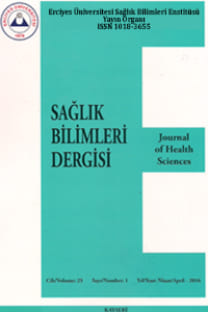ARTEMISIA ABSINTHIUM L., A. LUDOVICIANA NUTT. VE A. VULGARIS L. (ASTERACEAE) EKSTRE VE UÇUCU YAĞLARININ KARBAPENEM DİRENÇLİ SUŞLARA KARŞI IN VITRO ANTİBAKTERİYEL AKTİVİTESİNİN ARAŞTIRILMASI
Karbapenem direnci, Artemisia, uçucu yağ, metanol ekstre, antibakteriyel aktivite.
Investigation of in Vitro Antibacterial Activity against Carbapenem Resistant Strains Of Artemisia Absinthium L., A. Ludoviciana Nutt. And A. Vulgaris L (Asteraceae) Extract and Essential Oils
Carbapenem resistance, Artemisia, essential oil, methanol extract, antibacterial activity,
___
- 1. Yang S, Hemarajata P, Hindler J, et al. Investigation of a suspected nosocomial transmission of blaKPC3- mediated carbapenem-resistant Klebsiella pneumoniae by whole genome sequencing. Diagn Microbiol Infect Dis 2015; 84(4):337-342.
- 2. Paterson IK, Hoyle A, Ochoa G, et al. Optimising Antibiotic Usage to Treat Bacteria l Infections. Scientific Reports 2016; doi:10.1038/srep37853.
- 3. Capone A, Giannella M, Fortini D, et al. High rate of colistin resistance among patients with carbapenem ‐resistant Klebsiella pneumoniae infection accounts for an excess of mortality. Clin Microbiol Infec 2013; 19(1):E23-E30.
- 4. Kohler T, Michea-Hamzehpour M, Epp SF, et al. Carbapenem activities against P s e u d o m o n a s aeruginosa: respective contributions of OprD and efflux systems. Antimicrob Agents Chemother 1999; 43:424-427.
- 5. Nordmann P, Poirel L. Emerging carbapenemases in Gram-negative aerobes. Clin Microbiol Infec 2002; 8:321-333.
- 6. Aktas Z, Bal C, Midilli K, Poirel L, Nordmann P. First IMP-1- producing Klebsiella pneumoniae isolate in Turkey. Clin Microbiol Infec 2006; 12(7):695- 696.
- 7. Shah PM, Isaacs RD. Ertapenem, the first of a new group of carbapenems. A n t i m i c r o b A g e n t s Chemother 2003; 52(4):538-542.
- 8. Michalopoulos A, Virtzili S, Rafailidis P, et al. Intravenous fosfomycin for the t r e a t m e n t o f nosocomial infections caused by carbapenemresistant Klebsiella pneumoniae in critically ill patients: a prospective evaluation. Clin Microbiol Infec 2010; 16(2):184-186.
- 9. Do Amarante Melo GF, Vieira da Costa AC, et al. The sensitivity of bacterial foodborne pathogens to Croton blanchetianus Baill essential oil. Braz J Microbiol 2013; 44(4):1189-1194.
- 10.Bakkali F, Averbeck S, Averbeck D, Idaomar M. Biological effects of essential oils–a review. Food Chem Toxicol 2008; 46(2):446-475.
- 11.Sousa E, Silva N, Rodrigues, et al. Chemical composition and resistance modifying effect of the essential oil of Lantana camara Linn. Pharmacogn Mag 2010; 6(22):79-82.
- 12.Baytop T. Türkiye’de Bitkiler ile Tedavi (Geçmişte ve Bugün) (ilaveli 2. Baskı). Nobel Tıp Kitabevleri, İstanbul 1999; ss 313-315.
- 13.Erel ŞB, Reznicek G, Şenol SG, et al. Antimicrobial and antioxidant properties of Artemisia L. species from western Anatolia. Turk J Biol 2012; 36 (1):75- 84.
- 14.European Pharmacopoeia 6.0 Published in accordance with the convetion on the elaboration of a European Pharmacopoeia (European Treaty series No. 50.) European Directorate for the quality of Medicines and Healt Care, Council o f Europe, Vol. 2. Strasburg 2008.
- 15.Bazargani MM, Rohloff J. Antibiofilm activity of essential oils and plant e x t r a c t s a g a i n s t Staphylococcus aureus and Escherichia coli biofilms. Food Control 2016; 61:156-164.
- 16.Rubio-Moraga A, Argandona J, Mota B, et al. Screening for polyphenols, antioxidant and antimicrobial activities of extracts from eleven Helianthemum taxa (Cistaceae) used in folk medicine in south-eastern Spain. J Etnopharmacol 2013; 148:287-296.
- 17.Pai H, Kim JW, Kim J, et al. Carbapenem resistance mechanisms in Pseudomonas aeruginosa clinical isolates. Antimicrob Agents Chemother 2 0 0 1 ; 45:480-484.
- 18.Kordali S, Kotan R, Mavi, et al. Determination of the chemical composition and antioxidant activity of the essential oil of Artemisia dracunculus and of the antifungal and antibacterial activities of Turkish Artemisia absinthium, A. dracunculus, Artemisia santonicum, and Artemisia spicigera essential oils. J Agric Food Chem 2005; 53(24):9452-9458.
- 19.Kaya GI. Artemisia absinthium, FFD Monografları Tedavide Kullanılan Bitkiler. Ed. Demirezer Ö. Medikal & Novel Tıp Kitapsarayı Ankara, 2011; ss 83- 87.
- 20.Moslemi HR, Hoseinzadeh H, Badouei MR, et al. Antimicrobial Activity of Artemisia absinthium Against Surgical Wounds Infected by Staphylococcus aureus in a Rat Model. Indian J Med Microbiol 2012; 52:601-604.
- 21.Swamy MK, Akhtar MS, Sinniah UR. Antimicrobial Properties of Plant Essential Oils against Human Pathogens and Their Mode of Action: An Updated Review. J Evid Based Complement Altern Med 2016.
- 22.ESCOP Monographs. Absinthii Herba (2nd ed.) Thieme. New York NY 2003; pp 3-7.
- 23.Schimmer O, Krüger A, Paulini H, et al. An evaluation of 55 commercial plant extracts in the Ames mutagenicity test. Pharmazie 1994; 49:448-452.
- 24.Höld KM, Sirisoma NS, Ikeda T, et al. α-Thujone (the active component of a b s i n t h e ) : γ - aminobutyricacid type A receptor modulation and metabolic detoxification. Proc Natl Acad Sci USA 2000; 97:3826-3831.
- ISSN: 1018-3655
- Yayın Aralığı: 3
- Başlangıç: 1993
- Yayıncı: Prof.Dr. Aykut ÖZDARENDELİ
ÜNİVERSİTE ÖĞRENCİLERİNDE DÜZENLİ KAHVALTI TÜKETİMİ İLE ANTROPOMETRIK ÖLÇÜMLER ARASINDAKİ İLİŞKİ
Neslihan ÖNER, Zeynep CAFEROĞLU, Selçuk KORKMAZ
Sedat ÜNAL, Çiğdem YÜCEL, Serdar TORT, Merve Ç.TEKELİ, Yeşim AKTAŞ, Erem BİLENSOY
İbrahim YAVUZ, Elif Dilara ŞEKER
PEDİATRİK BÜYÜME EĞRİLERİNİN OLUŞTURULMASINDA KULLANILAN İSTATİSTİKSEL YÖNTEMLERİN KARŞILAŞTIRILMASI
FARKLI NAZOLABIAL AÇI ÖLÇÜM METOTLARININ SEFALOMETRIK VE FOTOGRAFIK DEĞERLENDIRILMESI
Ayşe BALDEMİR, Ülkü KARAMAN, Ufuk İNCE, Nilay ILDIZ, Ahmet Emre EKER
HUMAN PAPİLLOMA VİRÜS (HPV) GÜNCEL TEDAVİ VE KORUNMA YÖNTEMLERİ
Ufuk İNCE, Muhammed AKAR, Nilay ILDIZ
HEMŞİRELİK ÖĞRENCİLERİNDE KAVRAM HARİTASININ PROBLEM ÇÖZME VE ELEŞTİREL DÜŞÜNME DÜZEYLERİNE ETKİSİ
Emine ERDEM, Yağmur Sezer EFE, Öznur BAŞDAŞ, Meral BAYAT, Zübeyde KORKMAZ, Nevin USLU
Kurtuluş GÖK, Berrin Kocaoğlu GÜÇLÜ
RATLARDA DENEYSEL OLARAK BİFOSFONATA BAĞLI ÇENE OSTEONEKROZU OLUŞTURULMASI
